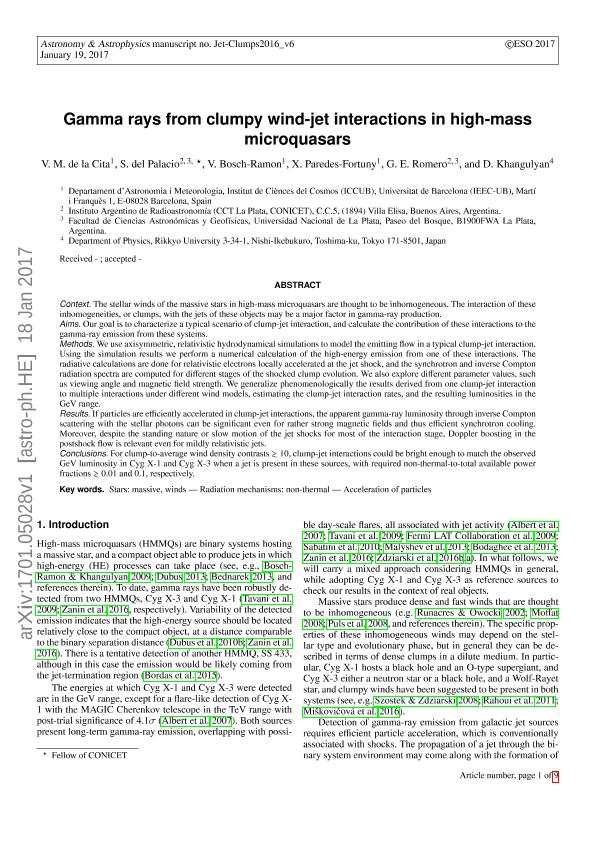Mostrar el registro sencillo del ítem
dc.contributor.author
De La Cita, V. M.
dc.contributor.author
del Palacio, Santiago

dc.contributor.author
Bosch Ramon, Valentí

dc.contributor.author
Paredes Fortuny, X.

dc.contributor.author
Romero, Gustavo Esteban

dc.contributor.author
Khangulyan, D.
dc.date.available
2018-10-30T14:38:01Z
dc.date.issued
2017-08
dc.identifier.citation
De La Cita, V. M.; del Palacio, Santiago; Bosch Ramon, Valentí; Paredes Fortuny, X.; Romero, Gustavo Esteban; et al.; Gamma rays from clumpy wind-jet interactions in high-mass microquasars; EDP Sciences; Astronomy and Astrophysics; 604; 8-2017; 1-9
dc.identifier.issn
0004-6361
dc.identifier.uri
http://hdl.handle.net/11336/63272
dc.description.abstract
Context. The stellar winds of the massive stars in high-mass microquasars are thought to be inhomogeneous. The interaction of these inhomogeneities, or clumps, with the jets of these objects may be a major factor in gamma-ray production. Aims. Our goal is to characterize a typical scenario of clump-jet interaction, and calculate the contribution of these interactions to the gamma-ray emission from these systems. Methods. We use axisymmetric, relativistic hydrodynamical simulations to model the emitting flow in a typical clump-jet interaction. Using the simulation results we perform a numerical calculation of the high-energy emission from one of these interactions. The radiative calculations are performed for relativistic electrons locally accelerated at the jet shock, and the synchrotron and inverse Compton radiation spectra are computed for different stages of the shocked clump evolution. We also explore different parameter values, such as viewing angle and magnetic field strength. The results derived from one clump-jet interaction are generalized phenomenologically to multiple interactions under different wind models, estimating the clump-jet interaction rates, and the resulting luminosities in the GeV range. Results. If particles are efficiently accelerated in clump-jet interactions, the apparent gamma-ray luminosity through inverse Compton scattering with the stellar photons can be significant even for rather strong magnetic fields and thus efficient synchrotron cooling. Moreover, despite the standing nature or slow motion of the jet shocks for most of the interaction stage, Doppler boosting in the postshock flow is relevant even for mildly relativistic jets. Conclusions. For clump-to-average wind density contrasts greater than or equal to ten, clump-jet interactions could be bright enough to match the observed GeV luminosity in Cyg X-1 and Cyg X-3 when a jet is present in these sources, with required non-thermal-to-total available power fractions greater than 0.01 and 0.1, respectively.
dc.format
application/pdf
dc.language.iso
eng
dc.publisher
EDP Sciences

dc.rights
info:eu-repo/semantics/openAccess
dc.rights.uri
https://creativecommons.org/licenses/by-nc-sa/2.5/ar/
dc.subject
Massive Stars
dc.subject
Accretion Disks
dc.subject
Binary Stars
dc.subject
Gamma Rays
dc.subject
Early Type Stars
dc.subject
X Ray Binaries
dc.subject
Winds
dc.subject
Radiation Mechanisms
dc.subject
Acceleration of Particles
dc.subject
Non-Thermal Mechanisms
dc.subject.classification
Astronomía

dc.subject.classification
Ciencias Físicas

dc.subject.classification
CIENCIAS NATURALES Y EXACTAS

dc.title
Gamma rays from clumpy wind-jet interactions in high-mass microquasars
dc.type
info:eu-repo/semantics/article
dc.type
info:ar-repo/semantics/artículo
dc.type
info:eu-repo/semantics/publishedVersion
dc.date.updated
2018-10-22T19:52:22Z
dc.journal.volume
604
dc.journal.pagination
1-9
dc.journal.pais
Francia

dc.description.fil
Fil: De La Cita, V. M.. Universidad de Barcelona; España
dc.description.fil
Fil: del Palacio, Santiago. Provincia de Buenos Aires. Gobernación. Comisión de Investigaciones Científicas. Instituto Argentino de Radioastronomía. Consejo Nacional de Investigaciones Científicas y Técnicas. Centro Científico Tecnológico Conicet - La Plata. Instituto Argentino de Radioastronomía; Argentina. Universidad Nacional de La Plata. Facultad de Ciencias Astronómicas y Geofísicas; Argentina
dc.description.fil
Fil: Bosch Ramon, Valentí. Universidad de Barcelona; España
dc.description.fil
Fil: Paredes Fortuny, X.. Universidad de Barcelona; España
dc.description.fil
Fil: Romero, Gustavo Esteban. Provincia de Buenos Aires. Gobernación. Comisión de Investigaciones Científicas. Instituto Argentino de Radioastronomía. Consejo Nacional de Investigaciones Científicas y Técnicas. Centro Científico Tecnológico Conicet - La Plata. Instituto Argentino de Radioastronomía; Argentina. Universidad Nacional de La Plata. Facultad de Ciencias Astronómicas y Geofísicas; Argentina
dc.description.fil
Fil: Khangulyan, D.. Rikkyo University; Japón
dc.journal.title
Astronomy and Astrophysics

dc.relation.alternativeid
info:eu-repo/semantics/altIdentifier/doi/http://dx.doi.org/10.1051/0004-6361/201630060
dc.relation.alternativeid
info:eu-repo/semantics/altIdentifier/url/https://www.aanda.org/articles/aa/abs/2017/08/aa30060-16/aa30060-16.html
Archivos asociados
